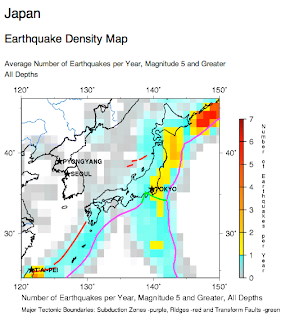This article was last updated on April 16, 2022
Canada: ![]() Oye! Times readers Get FREE $30 to spend on Amazon, Walmart…
Oye! Times readers Get FREE $30 to spend on Amazon, Walmart…
USA: ![]() Oye! Times readers Get FREE $30 to spend on Amazon, Walmart…
Oye! Times readers Get FREE $30 to spend on Amazon, Walmart…
The March 11th, 2011 earthquake in Japan, while huge in magnitude, was not entirely unexpected. Japan is located along the western edge of the Ring of Fire, a zone of frequent earthquakes and volcanic activity that rings the Pacific Ocean. Over 90 percent of the world’s total earthquakes and over 80 percent of the world’s major earthquakes take place along the active margins of the Pacific Ocean. Here is a map showing the Ring of Fire:
Tectonic activity along the Ring of Fire results from the collision and subduction of the world’s tectonic crustal plates that are “floating” on the underlying mantle layer. The massive earthquake and tsunami off the coast of Indonesia and the earthquakes associated with the San Andreas faults are related to their position along the Ring of Fire. Here is a diagram showing the internal structure of the earth:
Here is a map showing the world’s major tectonic plates:
Japan is an island arc created by the activity of the earth’s crustal layer as it moves on the underlying semi-solid mantle layer. Unfortunately, in the case of Japan, the country lies at the intersection of four tectonic plates; the North American Plate, the Eurasian Plate, the Pacific Plate and the Philippine Sea Plate. These plates all meet on the island of Honshu, the largest of the many islands that comprise the country of Japan. This makes the country extremely vulnerable to earthquakes, in fact, today’s earthquake took place off the coast of northern Honshu to the north of the city of Tokyo.
Here is a map showing Japan’s tectonic plates and the smaller faults (in red) associated with the larger plate boundaries:
It is the location of these plate boundaries that result in the massive number of earthquakes in Japan, estimated at over 1500 annually. Here is a map showing the annual frequency of earthquakes with a magnitude of five or greater in Japan:
In Japan, the Pacific Plate is sliding under the Eurasian Plate creating a subduction zone as the crust of the Pacific Plate is subducted (or goes under) into the earth’s mantle. This is termed a convergent zone by geologists. Because the crust is not perfectly smooth, it will lock in place as it is subducted and then suddenly release once pressure builds up and friction between the plates is overcome. It is this sudden release that created the earthquake on March 11th and the massive earthquake that killed 6400 people in Kobe Japan in 1995. Japan also experienced an even more massive earthquake in 1923; the Great Kanto earthquake killed over 140,000 people.
Here is a diagram showing how, in general, a crustal subduction zone works:
As the more dense oceanic crust of the Pacific Plate is subducted under the less dense continental crust of the Eurasian Plate, the oceanic crust is forced downward into the hotter earth’s mantle, where the oceanic crust heats up and melts, creating magma. This magma, which is lighter than the surrounding rock, rises to the surface and results in the creation of volcanoes. In Japan, Mount Fuji is a prime example of a perfect cone volcano formed as the melted and less dense earth’s crust rose back to the earth’s surface. As well, the over-riding plate is crushed along its leading edge, resulting in the formation of mountain chains as the crust is compressed and forced upwards. The sudden release of energy and movement of the earth’s crust during an earthquake displaces overlying ocean water. This results in the creation of a tsunami which, interestingly enough, is a Japanese world meaning “harbour wave”.
Here is a diagram showing how the crustal plates interact with each other in Japan:
I hope that this very basic primer in crustal geology will help explain why Japan experienced such a massive earthquake on March 11th, 2011. A very similar geological scenario exists along the west coast of North America, most particularly in the Pacific Northwest and it is just a matter of time before the “Big One” hits that portion of the Ring of Fire. Fortunately for Japan, the country has undertaken a massive program of earthquake preparedness over the past 50 years which will minimize the loss of life and property from this massive catastrophe.
Click HERE to read more of Glen Asher’s columns.
Article viewed at: Oye! Times at www.oyetimes.com
References:
You can publish this article on your website as long as you provide a link back to this page.








this is really sad i can not belive this happened to japan. first a earthquake then a tsunami